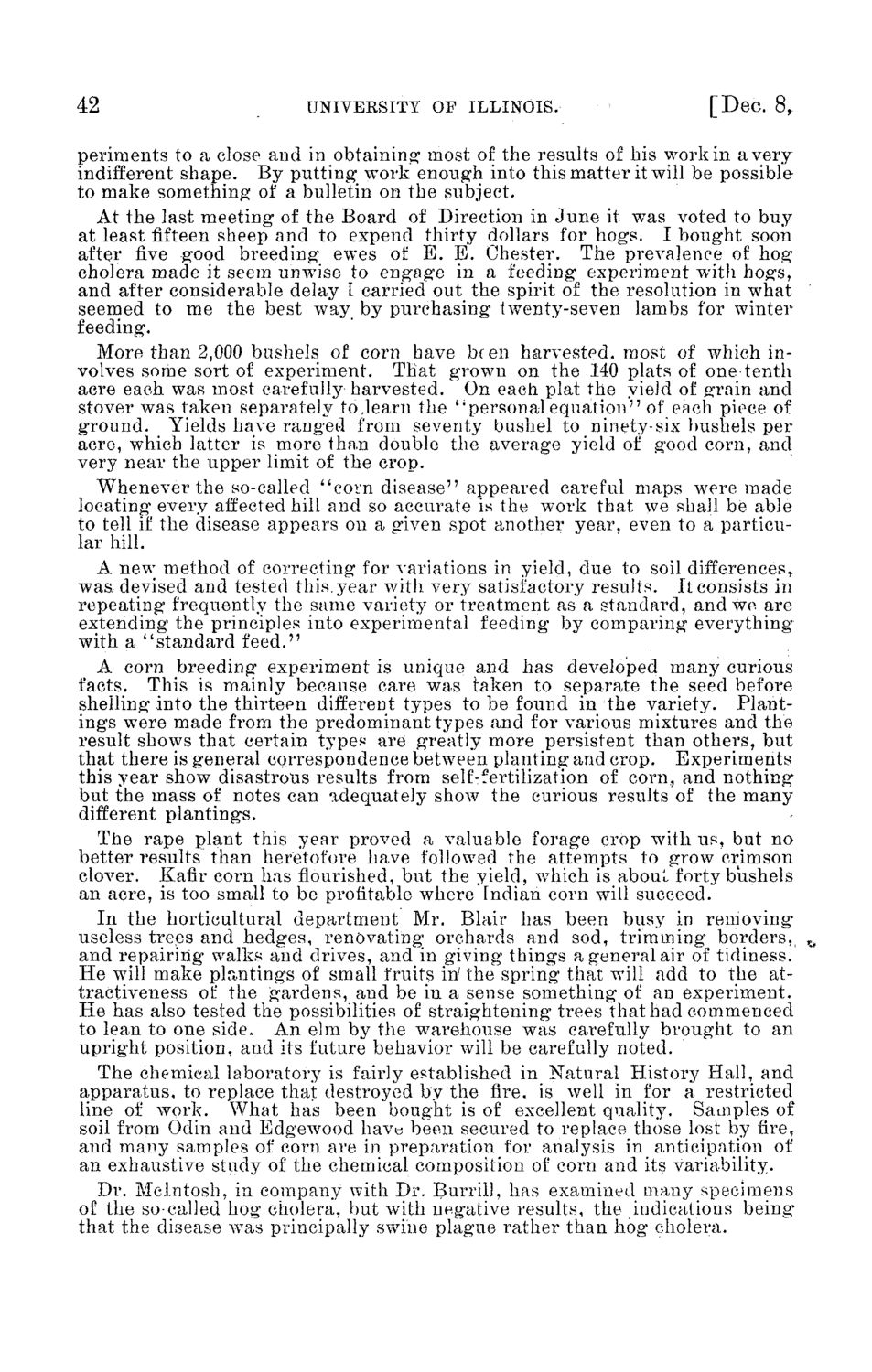| |
| |
Caption: Board of Trustees Minutes - 1898
This is a reduced-resolution page image for fast online browsing.

EXTRACTED TEXT FROM PAGE:
42 UNIVERSITY OF ILLINOIS. [ D e c . 8r periments to a close and in obtaining* most of the results of his work in a very indifferent shape. By putting* work enough into this matter it will be possible to make something of a bulletin on the subject. At the last meeting of the Board of Direction in June it was voted to buy at least fifteen sheep and to expend thirty dollars for hogs. I bought soon after five good breeding ewes of E. E. Chester. The prevalence of hog cholera made it seem unwise to engage in a feeding experiment with hogs, and after considerable delay 1 carried out the spirit of the resolution in what seemed to me the best way by purchasing twenty-seven lambs for winter feeding. More than 2,000 bushels of corn have been harvested, most of which involves some sort of experiment. That grown on the 140 plats of one tenth acre each was most carefully harvested. On each plat the yield of grain and stover was taken separately to,learn the "personal equation" of each piece of ground. Yields have ranged from seventy bushel to ninety-six bushels per acre, which latter is more than double the average yield of good corn, and very near the upper limit of the crop. Whenever the so-called "corn disease" appeared careful maps were made locating every affected hill and so accurate is the work that we shall be able to tell if the disease appears on a given spot another year, even to a particular hill. A new method of correcting for variations in yield, due to soil differences* was, devised and tested this.year with very satisfactory results. It consists in repeating frequently the same variety or treatment as a standard, and we are extending the principles into experimental feeding by comparing everything with a "standard feed." A corn breeding experiment is unique and has developed many curious facts. This is mainly because care was taken to separate the seed before shelling into the thirteen different types to be found in the variety. Plantings were made from the predominant types and for various mixtures and the result shows that certain types are greatly more persistent than others, but that there is general correspondence between planting and crop. Experiments this year show disastrous results from self-fertilization of corn, and nothing* but the mass of notes can adequately show the curious results of the many different plantings. The rape plant this year proved a valuable forage crop with us, but no better results than heretofore have followed the attempts to grow crimson clover. Kafir corn has flourished, but the yield, which is about forty bushels an acre, is too small to be profitable where Indian corn will succeed. In the horticultural department Mr. Blair has been busy in removing useless trees and hedges, renovating orchards and sod, trimming borders, and repairing walks and drives, and in giving things a general air of tidiness. He will make plantings of small fruits in/' the spring that will add to the attractiveness of the gardens, and be in a sense something of an experiment. He has also tested the possibilities of straightening trees that had commenced to lean to one side. An elm by the warehouse was carefully brought to an upright position, and its future behavior will be carefully noted. The chemical laboratory is fairly established in Natural History Hall, and apparatus, to replace that destroyed by the fire, is well in for a restricted line of work. What has been bought is of excellent quality. Samples of soil from Odin and Edgewood have been secured to replace those lost by fire, and many samples of corn are in preparation for analysis in anticipation of an exhaustive study of the chemical composition of corn and its variability. Dr. Mcintosh, in company with Dr. Burrill, has examined many specimens of the so-called hog cholera, but with negative results, the indications being that the disease was principally swine plague rather than hog cholera.
| |